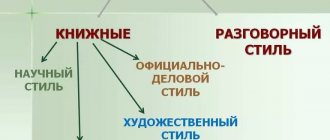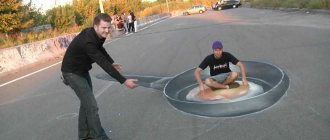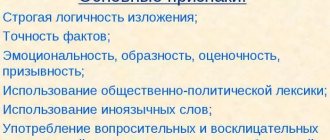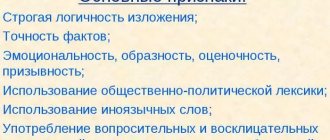In the modern Russian literary language, there are 5 functional styles of speech: colloquial, journalistic, official business, artistic and scientific style of speech.
In this article we will analyze in detail the scientific style of speech. You will find answers to the following questions:
- what is scientific style of speech;
- its main function and tasks;
- scope of application;
- features and characteristics of the scientific style;
- substyles or varieties;
- genres of scientific style of speech;
- example of a scientific text.
What is the scientific style of speech, its functions and tasks
The scientific style of speech is a functional style of speech of the Russian literary language, which is a means of communication in the field of scientific, scientific-professional and educational-scientific activities.
The main function of the scientific style of speech is informative. It consists in conveying objective information about man, nature, and society.
The task of the scientific style is to explain natural and social phenomena, identify patterns and identify cause-and-effect relationships.
Scientific style texts are distinguished by clarity, logic, accuracy, objectivity and evidence-based presentation of information.
Scope of application of scientific style
The scope of application of the scientific style of speech is the field of science and educational and scientific activity.
First of all, it is used in written form of speech: textbooks, articles, dissertations, reports, encyclopedias, etc. But it is also found in oral form (for example, during scientific conferences).
To design presentations, printed materials, and publications, I recommend using Canva. This is a very simple and convenient all-in-one visual editor. With thousands of professional templates, images, and other quality elements, you'll get a great starting point to bring your best ideas to life.
Places of publication
The choice of a printed publication is influenced by the level of qualifications of the author and the quality of the work performed. If it is appropriate for an undergraduate student to publish a debut article in the “Bulletin” of his university, then a graduate student needs to have the material accepted in one of the journals reviewed by the Higher Attestation Commission (Higher Attestation Commission). Holders of academic titles working in research institutes publish works in conference collections (including international ones), as well as periodicals, which are indexed in special databases.
The material must be accepted in one of the journals reviewed by the Higher Attestation Commission.
Main features and characteristics of the scientific style of speech
The features and characteristics of the scientific style include:
- Logical presentation - information is presented consistently and in a clear sequence.
- Generality, accuracy and objectivity in the presentation of information.
- Evidentiary and rich presentation (many arguments, facts).
- Application of terms and general scientific words. On average, terms occupy about 15-20% of the total text volume.
- The use of words with an abstract meaning (these are words that do not evoke specific images in the mind and memory, for example: property, essence, worldview, reality).
- Most often there is a monologue character of speech.
- More nouns and adjectives, and a minimum of verbs.
- Complex sentence construction.
- The sentences are mostly long.
- Practically no means of expression are used (epithets, comparisons, metaphors, etc.) and there is no expressive-emotional vocabulary (admirable, son, inspire, despise, sycophant).
- Correct word order.
- Strict sequence of presentation.
Common mistakes in the writing process
Beginning authors often make the following typical mistakes that lead to editors rejecting their articles:
- Emotional or misleading headline. Instead of the typical tabloid title “Where is the country’s economy heading?” The title should be formulated as “Possible ways of economic development of the state in the current political conditions.”
- Use of colloquial vocabulary, neologisms and slang. The style of writing such texts is scientific and journalistic, it uses special terms, introductory words (which should not be overused), neutrally colored phrases and sentences. It is possible to use verbs in the first person plural (“we affirm/work/came to a conclusion”).
- Violation of logic in the presentation of thoughts. Unexpected conclusions, adjustment of data, confusion in definitions prevent one from understanding the meaning of what is written and makes a negative impression on the reader.
- The presence of unproven statements. All stated premises and facts must be confirmed.
- Lack of indications of sources of information. Any borrowing should be provided with a link to the source material so that the author is not accused of plagiarism.
- Low uniqueness score. Checking the text in the Anti-Plagiarism system is mandatory. Different publications have their own requirements for the number of citations, since when writing reviews or theoretical works that are a compilation of indexed sources, the indicator may be low. This parameter needs to be clarified before sending the text, and low uniqueness needs to be raised to an acceptable value.
Many shortcomings appear as a result of careless, quick and superficial processing of the material, so writing an article should take at least several weeks. This stage is often preceded by months of theoretical research and laboratory experiments. The finished text must be proofread and approved by the supervisor.
Scientific style of speech: its varieties or substyles
Like other styles of speech, the scientific style is rarely found in its “pure” form. Scientific texts may contain elements of both journalistic and official business style of speech.
Because of this interaction with other styles of speech, and depending on the purpose and specific application, the scientific style is divided into 6 substyles :
- Proper scientific or academic: dissertations, reports, communications, monographs, speeches;
- Educational and scientific: textbooks, lecture courses, course work, seminar report;
- Popular science: popular science books and magazines, children's encyclopedias;
- Scientific and informative: abstracts, reviews, summaries, theses;
- Scientific reference: encyclopedias, dictionaries, reference books;
- Scientific and technical: patents, standards, descriptions of inventions, specifications, technical conditions.
| Substyle name | Target | Genres |
| Actually scientific | Definition and description of new phenomena, facts, patterns. | dissertations, reports, communications, monographs, speeches, scientific articles. |
| Educational and scientific | Transferring scientific information to students, teaching, describing the facts necessary for mastering and mastering the material. | textbooks, lecture courses, course work, seminar report, notes, oral response. |
| Popular science | Familiarization with facts and phenomena. | popular science books and magazines, children's encyclopedias, articles. |
| Scientific and informative | Transmission of scientific information with a description of scientific facts. | abstracts, reviews, theses. |
| Scientific reference | Providing the reader with the ability to quickly find the necessary scientific information. | encyclopedias, dictionaries, reference books. |
| Scientific and technical | Application of scientific achievements in practice. | patents, standards, descriptions of inventions, specifications, technical conditions. |
Substyles (varieties) of scientific style of speech and examples of genres
Where to find the information you need
Select information for writing an article in thematic periodicals, collections of works, monographs and dissertations of scientists. The search is carried out using keywords. In addition, you can use statistical data (for example, when writing articles on economic and legal disciplines). It is useful to refer to reference lists in articles and books on the topic being developed.
The necessary information for the article is contained in thematic periodicals and collections of works.
Genres of scientific style of speech
Genres of scientific style are types of scientific texts that differ in their structure and functions.
There are several classifications of genres of scientific style. For example: primary and secondary scientific works or genres with free (articles, reviews) and with a fixed writing structure (dissertation).
In this article we will consider the classification of genres depending on the specific communicative and information functions that they perform.
Scientific style of speech: genres of the scientific substyle
The main function of this substyle is to identify and describe original research results, to present new facts, phenomena and patterns.
Genres of the scientific sub-style include:
- A monograph is a scientific study devoted to one specific phenomenon, fact, issue or topic. The volume of the classic text of the monograph is more than 120 pages in A4 format. This is a full-fledged scientific work.
- A scientific article is a short essay in which the author describes the results of his own research.
- A dissertation is a qualifying work, the successful completion of which is necessary for the award of an academic degree. Volume: from 50 to 500 pages. Available in the form of a book or bound manuscript.
Genres of this substyle also include reports, messages, and speeches.
Texts of the proper scientific substyle have a general writing structure, which includes:
- Name.
- Introduction.
- Main part.
- Conclusion.
Genres of educational and scientific substyle
Educational and scientific speech is used in the learning process, namely for the transmission and development of scientific information by students.
There are oral and written genres of educational and scientific substyle. Oral ones include: message and response .
The main written genres of this substyle are:
- A report is a detailed message on a specific issue, based on documentary data. The purpose of the report is to inform and provide recommendations or suggestions.
- A textbook is a teaching tool designed to assimilate, deepen and expand knowledge.
- Note - a summary or brief recording of a lesson, lecture, article.
- A course of lectures is a collection of lecture texts by one or more authors on individual topics or on the course as a whole. Covers the content of the academic discipline.
Popular science genres
This substyle is intended to disseminate scientific information among the mass recipient (for example, among a certain category of readers - children, teenagers, etc.).
Popular science genres include:
- Popular science books are literary works about science, scientists, scientific achievements and research, intended for a wide range of readers.
- Popular science magazines.
- Children's encyclopedias.
- Articles.
Genres of the scientific and information substyle
The function of the scientific information substyle is to convey scientific information.
The main genres of this substyle:
- An abstract is a short report on a specific topic, which collects information, most often from several sources.
- A review abstract is a report that compares different points of view on a particular issue. Compiled based on several sources.
- An abstract is a short report that outlines only the main points.
- The thesis is the leading genre of scientific style. It is a short record that outlines the main points of scientific research.
Genres of scientific reference substyle
The task of the scientific reference sub-style is to provide the reader with the ability to quickly find the necessary scientific information.
The main genres of the scientific reference substyle are:
- Encyclopedia is a scientific reference review of all or individual branches of knowledge in the form of a dictionary.
- A dictionary is a collection of words with their translation, interpretation and explanation.
- A reference book is a book that contains brief information of a scientific, social, industrial or applied nature.
- Catalog is a list of information about objects, the purpose of which is to facilitate the search for these objects by a certain criterion.
Scientific style of speech: genres of the scientific and technical substyle
The scientific and technical substyle is common in technical documentation. The texts of this substyle serve to apply in practice all the achievements that have been obtained as a result of theoretical and experimental scientific research.
The genres of the scientific and technical substyle include:
- A patent is a document certifying the exclusive right to an invention, product or process.
- Specification is a definition and list of specific features, a refined classification of something.
- Technical specifications are a document establishing the technical requirements that a specific product, material, substance, etc., or a group of them must meet.
- Standards.
- Description of inventions.
Step-by-step writing instructions
Research papers cannot be written from scratch, without prior preparation and agreement of the topic with the supervisor.
The author should adhere to the following sequence of actions:
Select your area of study.
Select an area of study. It is better to narrow the range of problems under consideration, since it will not be possible to cover all aspects of a broad topic in an article of 10-15 pages. At the same time, it is necessary to take into account the degree of study of the issue, so as not to unwittingly duplicate the already published publications of other researchers.- Decide under whose guidance to write. To do this, you need to talk with one of the teachers at your university. It is important that the specialist has publications on the same or related topic.
- Determine where to send the article. The choice of journal should be discussed with the supervisor after independently studying periodicals and their requirements for authors.
- Pick up
Structure of scientific text
Any scientific text, regardless of genre, is built according to a single logical scheme.
The basis is always a thesis - a statement that requires justification. To confirm and substantiate this thesis, the text must present argumentation and provide evidence . Often, for a more complete argument, illustrations - examples that confirm the scientific assumptions put forward.
The text ends with a conclusion or summary , which outlines an assessment of the research conducted and also presents prospects for further study.
Who writes and why?
The authors of the articles are scientists of all levels: from students who are taking their first steps in the scientific field to professors who have been working in their chosen field for decades. Articles written while studying at a university often form the basis of a graduate’s thesis. Graduate students are required to present a number of publications in peer-reviewed journals in order to receive permission to defend a dissertation and seek an academic degree.
Researchers who work in various scientific institutions have their own standards for writing articles.
The number of such works determines the scientist’s rating, his authority in scientific circles, as well as his salary.
An example of texts written in a scientific style of speech
“A tornado is a strong small-scale vortex that arises in a thunderstorm (cumulonimbus) cloud and spreads in the form of a dark “trunk” towards the water or earth’s surface.
In the upper part, below the lower boundary of the cloud, the vortex has a funnel-shaped expansion. The barrel of a tornado descends to the earth's surface, its lower part, in contact with it, takes the form of an overturned funnel. The height of a tornado can reach 800–1500 m. The air in it rotates most often counterclockwise, rising in a spiral upward, drawing in dust or water, and fragments of objects destroyed on the ground.
The air rotation speed can reach 50–100 m/s with a strong upward component and cause catastrophes. destruction, sometimes accompanied by loss of life. At the same time, near his path there may be complete calm. Inside the tornado, the air pressure decreases, condensation of water vapor occurs there, which, together with the elongated part of the cloud, dust, water and decomposition. the debris makes death visible. Its axis is vertical, but often has a curved appearance.”
Electronic encyclopedia
» Existing territorial planning schemes for environmental management do not contribute to the creation of environmentally-oriented economic activities, which leads to conflict situations between economic entities both within the Kaliningrad region and outside it. Analysis of the features of socio-economic development and environmental policy made it possible to identify a number of significant methodological and methodological shortcomings in territorial planning and development. In particular, the development of the Kaliningrad region is carried out on the basis of poorly coordinated and poorly environmentally oriented departmental plans: urban planning, agricultural, reclamation, water, forest management, recreational and others.
Environmentally-oriented landscape planning can help in solving problems of territorial development. The landscape program of the Kaliningrad region is a strategic planning document for the use of the territory, forming an information and reference field for a wide range of organizations and officials responsible for the development and adoption of management territorial planning decisions, as well as state and non-state environmental and environmental funds, international organizations in the field of environmental control and management.
One of the most important tasks in implementing the program is the development of an integrated map of environmentally-oriented use of the territory and a map of environmental management conflicts. Solving these problems without the use of geographic information technologies is very complicated and sometimes impossible.”
Excerpt from the scientific article “Introduction of open geoinformation technologies into environmental planning methods”
Information sources:
- Russian language for technical universities. Scientific style. Author: Yu. Smirnova
- Wikipedia
- Russian language and culture of speech. Authors: Tatyana Balykhina, Mikhail Rybakov, Marina Lysyakova.
- Stylistics of scientific speech and editing of educational and methodological materials. A textbook for teachers and educators of the secondary education system.
- Photo on the cover of the article - science.sciencemag.org
PS: Did you like the article? Share the link on social networks, thank you!
Where to begin
First, you should think about the topic of your future publication and build a rough work plan.
Choosing a theme
The topic of the article depends on the interests of the author, the degree of study of the chosen problem, and the presence of scientific supervisors at the university who have dealt with similar problems. If the issue has been raised many times by predecessors, it is important to understand whether it will be possible to look at it differently and apply new developments and information to solve it. You can examine publications on the topic over the past few years to follow the development of hypotheses and determine what aspects other researchers have not taken into account.
The topic of the article depends on the degree of study of the chosen problem.
Planning
There are 2 types of plans:
- Informal (unofficial), which the author develops for himself in order to avoid unnecessary actions and searches.
- Formal, which is checked and approved by the supervisor.
The first option is compiled in any form, while in the second it is necessary to indicate all the headings that will later be included in the final text.
In each paragraph of the formal plan, you need to describe what will be discussed in the subsection.









